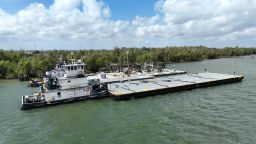The saltwater wedge threatening New Orleans drinking water has been delayed by several weeks in its upstream trek on the Mississippi River thanks to better-than-forecast river flows last month, officials in Louisiana said Thursday.
Because of this delay, the large water treatment intakes around New Orleans – including the Carrollton intake, which serves most of the city – might not see saltwater inundation through the end of November, if at all.
The forecast from the US Army Corps of Engineers now expects saltwater to reach New Orleans’ smaller Algiers water treatment intake around November 23, and the Gretna intake around November 26. Gretna is the last intake the Army Corps includes in its forecast.
“Currently, through our extended forecast through the month of November, we see the potential for no chloride impacts affecting West Jefferson, Carrollton and Eastern Jefferson water treatment facilities,” Col. Cullen Jones, commander of the Corps’ New Orleans office, said at a news conference Thursday.
Jones called this a “conservative” forecast that assumes little-to-no rain in October and November.
The saltwater wedge has remained just south of Belle Chasse since September 24, when the Corps began expanding the underwater sill.
“We’re making great progress” on the underwater sill, Jones said, noting the expansion is currently 62% complete and that the Corps is aiming to have it done by October 12. “We are ahead of schedule.”
“This updated projection is clearly a relief to all of us,” said Collin Arnold, director of homeland security and emergency preparedness for the city of New Orleans. “But our job in emergency management is to help prepare for the worst.”
Last week, New Orleans officials announced a multimillion-dollar pipeline would be needed to deliver freshwater from upstream to keep saltwater out of the city’s water treatment facilities. While contractors are already in place to build the temporary pipeline, Ron Spooner, interim general superintendent of the New Orleans Sewerage and Water Board, said they are holding back parts of the plan to explore more permanent solutions.
“We intend to stand the course until the situation is completely resolved,” Spooner said. “We want to be clear, no plans are being canceled, and in fact, it’s quite the opposite. This gives us time for more planning.”
Jefferson Parish had been planning to build 15 miles of flexible pipeline up the river to draw in fresh water. They are now planning to build about half of that, said parish president Cynthia Lee Sheng, partly to test it.
So, in the “very, very worst-case scenario, we’re not caught off guard,” Sheng said. “And that’s the position, and again with emergency management situations and with our team, we want to pivot as much as the current information allows us to do so.”
On a Zoom call earlier Thursday, Anna Nguyen, the New Orleans Homeland Security and Emergency Preparedness public information officer, told business owners and residents to have a contingency plan if saltwater gets into the city’s drinking water, but assured them that inundation is not imminent.
“I’m here to guarantee that this is not something you need to worry about yet. As soon as we think that you need to worry about it, we will let you know.” Nguyen said. “You do not have to worry. This is not the time to panic.”
Nguyen also noted that business owners are not being asked to buy salt-filtering reverse osmosis machines at this time.
“We’re not asking people to go buy reverse osmosis machines. We feel really confident in the plan that sewerage and Water Board and the state and steps NOLA Ready team is putting together to make sure that that’s not something that you have to consider,” Nguyen said.





